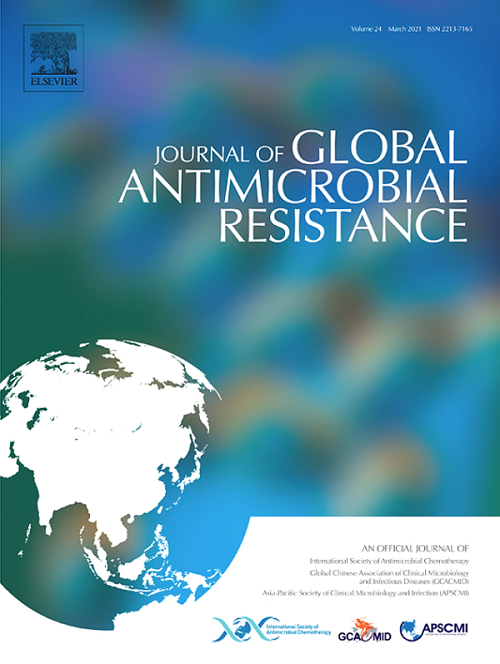Nasopharyngeal carriage, serotype, antimicrobial susceptibility, and genotype of pneumococci in young healthy children attending daycare centres in Klang Valley, Malaysia
IF 3.2
3区 医学
Q2 INFECTIOUS DISEASES
引用次数: 0
Abstract
Objective
Implementation of pneumococcal conjugate vaccines (PCV) targeting selected serotypes has led to a decrease in invasive pneumococcal diseases. In Malaysia, PCV10 was recently included in the national immunisation programme. Therefore, monitoring serotype distribution and antimicrobial resistance of pneumococci in high-density areas is crucial. This study investigated the serotype distribution, antimicrobial resistance pattern, and genotype of pneumococci in healthy children below 5 years old attending daycare centres in Klang Valley, Malaysia, while indirectly assessing transmission dynamics through nasopharyngeal carriage.
Methods
168 children across 25 daycare centres provided parental consent. Nasopharyngeal swabs collected between January 2023 and May 2024, were analysed for pneumococcal carriage, and serotyped by PCR. Antimicrobial susceptibility was determined using E-test assay. Multilocus sequence typing was performed on isolates with reduced susceptibility.
Results
The pneumococcal carriage rate was 22.6%. Serotype 15C was the most prevalent (15.8%), followed by 23A and 11A. In the E-test assay, 47.4% isolates were resistant to erythromycin, 28.9% to tetracycline, and 5.3% to penicillin. One isolate was resistant to ceftriaxone, whereas none demonstrated resistance to cefotaxime; reduced susceptibility to the two antibiotics was observed in one isolate, while two others had intermediate susceptibility to either ceftriaxone or cefotaxime alone. Sequence type distribution was diverse, with ST338 being the most common (n = 3).
Conclusions
The predominance of nonvaccine serotypes, particularly 15C and 23A, alongside antibiotic resistance, indicates a potential epidemiological shift in the post-PCV era. These results emphasise the need for continuous surveillance to monitor serotype dynamics and antimicrobial resistance pattern in the community.
在马来西亚巴生谷日托中心就读的健康幼童的鼻咽携带、血清型、抗菌药物敏感性和肺炎球菌基因型
背景:肺炎链球菌是一种呼吸道病原体,常见于儿童和老年人的鼻咽部,已确定有101种血清型。针对肺炎球菌相关疾病的肺炎球菌结合疫苗(PCV)的实施导致了侵袭性肺炎球菌疾病(IPD)的减少。在马来西亚,PCV10于2020年底被纳入国家免疫规划。因此,监测高密度地区的血清型分布和抗菌素耐药性对疫苗评估和公共卫生战略至关重要。目的:本研究旨在调查马来西亚巴生谷日托中心5岁及以下健康儿童肺炎球菌的血清型分布、抗菌素耐药性模式和遗传特征,同时间接评估通过鼻咽运输的传播动态。材料和方法:来自25个日托中心的168名儿童提供了同意书,并在2023年1月至2024年5月期间收集了他们的鼻咽拭子,分析了肺炎球菌携带情况,并通过PCR进行了血清分型。采用E-test法进行药敏试验。对敏感性降低的分离株进行多位点序列分型(MLST)和系统发育分析。结果:肺炎球菌携带率为22.6%。15C型最为常见(15.8%),其次是23A型和11A型(各占13.2%)。在e试验中,47.4%(18/38)的菌株对红霉素耐药,28.9%对四环素耐药,5.3%对青霉素耐药。一株分离株对头孢曲松耐药,而没有一株对头孢噻肟耐药;其中一株对两种抗生素的敏感性降低,而另外两株对头孢曲松或头孢噻肟均有中等敏感性。序列类型(ST)分布多样,以ST338最为常见(n = 3)。结论:非疫苗血清型(NVTs)的显著优势,特别是15C和23A,以及显著的抗生素耐药性,特别是对红霉素和四环素的耐药性,表明后pcv时代可能发生流行病学转变。这些结果强调需要持续监测,以监测社区的血清型动态和抗微生物药物耐药性模式。
本文章由计算机程序翻译,如有差异,请以英文原文为准。
求助全文
约1分钟内获得全文
求助全文
来源期刊

Journal of global antimicrobial resistance
INFECTIOUS DISEASES-PHARMACOLOGY & PHARMACY
CiteScore
8.70
自引率
2.20%
发文量
285
审稿时长
34 weeks
期刊介绍:
The Journal of Global Antimicrobial Resistance (JGAR) is a quarterly online journal run by an international Editorial Board that focuses on the global spread of antibiotic-resistant microbes.
JGAR is a dedicated journal for all professionals working in research, health care, the environment and animal infection control, aiming to track the resistance threat worldwide and provides a single voice devoted to antimicrobial resistance (AMR).
Featuring peer-reviewed and up to date research articles, reviews, short notes and hot topics JGAR covers the key topics related to antibacterial, antiviral, antifungal and antiparasitic resistance.
 求助内容:
求助内容: 应助结果提醒方式:
应助结果提醒方式:


